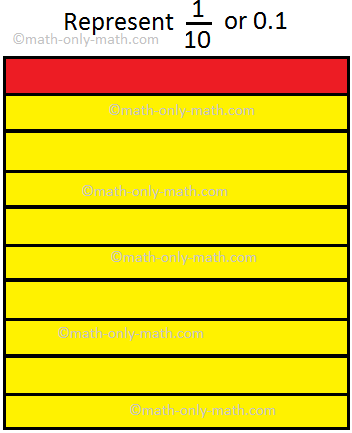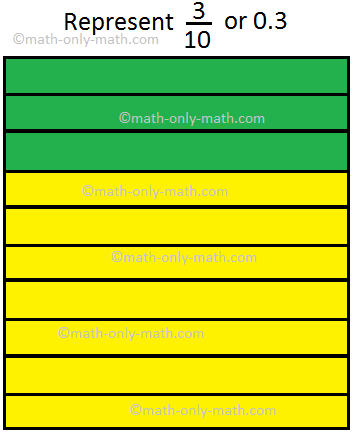Subscribe to our ▶️ YouTube channel 🔴 for the latest videos, updates, and tips.
Tenths Place in Decimals
The first place after the decimal point is tenths place which represents how many tenths are there in a number.
● Let us take a plane sheet which represents one whole. Now, divide the sheet into ten equal parts. Each part represents one tenth of the whole.
It is written as \(\frac{1}{10}\). In the decimal form it is written as 0.1, where the whole number part is zero and the fractional part is \(\frac{1}{10}\).
It is read as zero pint one. So, a decimal (point) is placed between the whole number and the fractional number. All the numerals after the decimal shows that it is less than a whole.
The number before decimal point is called the integral part or whole and the number after the decimal is called the decimal part.
● Now let us color 3 strips of the tenths sheet.
The colored part is represented as \(\frac{3}{10}\). In the decimal form it is written as 0.3. It is read as zero point three.
● Look at the strip in figure. It is divided into ten equal parts and one part is shaded. The shaded part represents one tenth of the whole strip.
It is written as \(\frac{1}{10}\) 0.1 and read as 'point one' or 'decimal one' or 'zero point one'.
Thus, the fraction, \(\frac{1}{10}\) called one-tenth and written as 0.1.
● Now look at the strip in figure
It is divided into ten equal parts and 7 parts are shaded. The shaded parts represent seven- tenths of the whole strip. It is written as \(\frac{7}{10}\) or 0.7 and is read as point seven or decimal seven.
Similarly, \(\frac{2}{10}\), \(\frac{3}{10}\), \(\frac{4}{10}\), \(\frac{5}{10}\), \(\frac{6}{10}\), \(\frac{7}{10}\), \(\frac{8}{10}\) and \(\frac{9}{10}\) are read as two-tenths, three-tenths, four-tenths, five-tenths, six-tenths, seven-tenths, eight-tenths and nine-tenths respectively and are denoted by 0.2, 0.3, 0.4, 0.5, 0.6, 0.7, 0.8 and 0.9 respectively.
Similarly,
\(\frac{11}{10}\) = 11 tenths = 10 tenths + 1 tenth = 1 + \(\frac{1}{10}\) = 1 + 0.1 = 1.1,
\(\frac{12}{10}\) = 12 tenths = 10 tenths + 2 tenths = 1 + \(\frac{2}{10}\) = 1 + 0.2 = 1.2,
\(\frac{20}{10}\) = 20 tenths = 10 tenths + 10 tenths = 1 + 1 = 2,
\(\frac{25}{10}\) = 25 tenths = 20 tenths + 5 tenths = 2 + 0.5 = 2.5
From the above discussion, we observe that a fraction in the form \(\frac{\textrm{number}}{10}\) is written as a decimal obtained by putting decimal point to the left of the right-most digit.
\(\frac{759}{10}\) = 75.9,
\(\frac{5805}{10}\) = 580.5,
\(\frac{43001}{10}\) = 4300.1, etc
From Tenths Place in Decimals to HOME PAGE
Didn't find what you were looking for? Or want to know more information about Math Only Math. Use this Google Search to find what you need.






New! Comments
Have your say about what you just read! Leave me a comment in the box below. Ask a Question or Answer a Question.